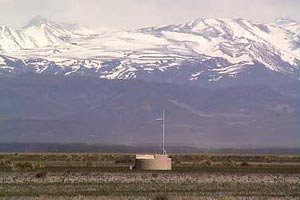Auger may clear up contradictory data on high-energy cosmic rays
By Steve KoppesNews Office
 Above is a photo of the high-energy cosmic ray surface detector stationed in the Mendoza Province of Argentina, where University scientists are conducting the Auger Project. |
“I don’t know what you’re talking about,” the guard told Olinto, Associate Professor in Astronomy & Astrophysics. “Open the car. We have to see everything.”
Incredulous, another guard intervened. “You mean you don’t know what the high-energy cosmic rays are?” he asked the first guard.
“They didn’t open our car. They let us go,” said Olinto, laughing at the memory. “He was very ashamed that he didn’t know what ultra-high-energy cosmic rays were.”
High-energy cosmic rays are subatomic scraps of matter that fly through the universe at nearly the speed of light. They can hit Earth’s atmosphere with the energy of a tennis ball traveling at 167 miles an hour.
Some mysterious source from beyond the galaxy periodically zaps Earth with the particles from all directions. So far, the two leading experiments devoted to the detection and understanding of these rays have yielded contradictory results. The Auger Project likely will change all that, Olinto told colleagues at the American Association for the Advancement of Science’s annual meeting in Denver in February.
“Right now theorists are having a lot of fun because we have two possible outcomes–and maybe a third one–that both experiments are incorrect and there’s a third explanation,” Olinto said.
A collaboration of more than 250 scientists in 16 nations operates the Auger experiment. The project was co-founded by James Cronin, a Nobel laureate and University Professor Emeritus in Physics. The project carries the name of Pierre Auger, the scientist who, in 1938, discovered the existence of particle showers on Earth that are produced by cosmic rays.
High-energy cosmic rays are relatively rare. They occur only once in a century over a given square kilometer of land–thus the large size of high-energy cosmic ray experiments. When complete, the Auger experiment will consist of a grid of electronic instruments that covers 1,200 square miles of Argentinean plains, an area more than half the size of the state of Delaware.
When a cosmic ray strikes Earth, it reacts with atoms in the atmosphere to create a cascade of a billion particles that shower the ground. Utah’s existing High Resolution Fly’s Eye detects cosmic rays by observing the fluorescent light they cause when they strike the atmosphere. Japan’s current Akeno Giant Air Shower Array detects the cascade of secondary particles when they strike the ground. Auger will use both techniques on a larger scale and should resolve the data discrepancy between the other two instruments.
For years it seemed that cosmic rays emanated from all over the sky, but that is no indication of their origin. That is because the rays are electrically charged, and magnetic fields deflect their paths as they travel through the universe. But at the very highest energies, the rays will travel a direct line from their source to Earth, enabling scientists to pinpoint where they originated.
Japan’s AGASA has begun to see a hint of clusters of particles coming from the same region. AGASA also sees cosmic rays at unexpectedly high energies.
“That is really exciting, because if AGASA is really finding particles above the energy where we thought they wouldn’t be, then there’s a whole new class of cosmic particle accelerators that nobody has predicted,” Olinto said.
Meanwhile, Utah’s HiRes detector has observed neither clustering nor cosmic rays at unexpectedly high energies. But as Auger grows from its current 30 detectors to 1,600 detectors in the coming years, it should be able to settle the discrepancy. “I believe AGASA has a better case for being correct,” Olinto said. “I also hope AGASA is correct–it will be a lot more fun.”
Some scientists have proposed that the high-energy cosmic rays are produced by jets of matter emitted by super-massive black holes or by gamma-ray bursts, which are the most powerful explosions in the universe. Another possibility is topological defects, stresses and strains comparable to faults and folds in the Earth’s crust, which periodically release tremendous energies generated early in the history of the universe.
Spinning neutron stars within the Milky Way galaxy are yet another explanation, according to a proposal put forward by Olinto and her colleagues from the Astrophysical Observatory in Arcetri, Italy, and Los Alamos National Laboratory.
“A very young neutron star could be spinning so fast, 3,000 times a second, that its strong magnetic fields could hit these particles, almost like a baseball bat, to incredible energies,” Olinto said.
Only time will tell which theory, or another one entirely, proves correct. “Right now we have a lot of fun things to debate,” she said.
![[Chronicle]](/images/sidebar_header_oct06.gif)